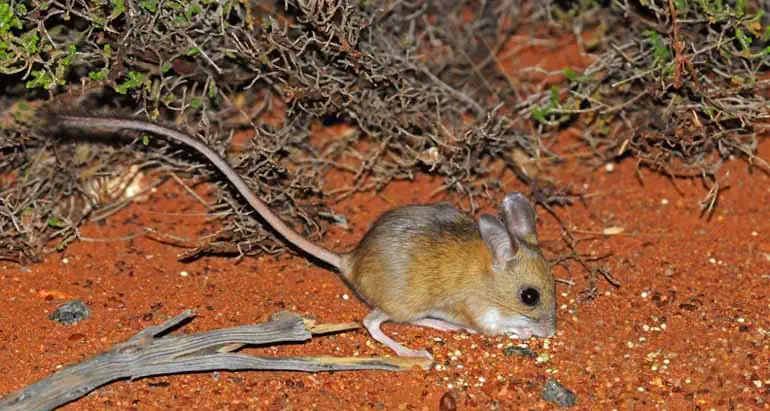Spinifex Hopping Mouse
The spinifex hopping mouse (Notomys alexis) inhabits the central and western Australian arid zones. It lives in spinifex-covered sand flats, sand dunes, loamy mulga, and melaleuca flats. We would mostly see them at night, bounding quickly across open ground or the road on their big hind feet, tails extended behind, and the body almost horizontal.
There are about ten different Australian native mice in the genus Notomys. They are all rodents and not marsupials. The ancestors arrived from Asia 5 million years ago.
Like many Central desert mammals, they can survive without drinking water. The native mouse has very effective kidneys that absorb every water drop from their waste. It has the most concentrated urine of any mammal ever recorded worldwide! The mice’s diet consists of seeds, roots, green shoots and invertebrates.
Spinifex Hopping Mouse
The Spinifex Hopping mouse has light brown fur, a grey-white belly, enormous ears, and a long, brush-tipped tail, 13–15 cm (5-6 inches) long. In average seasons it is sparsely distributed, although the populations do fluctuate. Confined to sandy country, the population explodes after rain and spreads to other habitat types for a while.
Breeding of the spinifex hopping mouse is quite flexible and can occur throughout the year, depending on environmental conditions. Spring is the most favourable time for mating. Generally, pregnancy lasts between 38–41 days. However, if the mother still cares for a previous brood, this period is extended significantly. Litters usually consist of three or four young, with six being the maximum. The young are typically kept in the nest while the female forages, and if they wander, both male and female adults will come to retrieve them. By two and a half months of age, these mice reach sexual maturity.
Margarita Steinhardt took the image in the header from The Wildlife Diaries.


